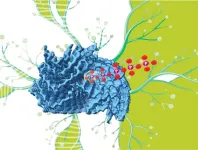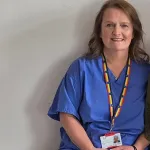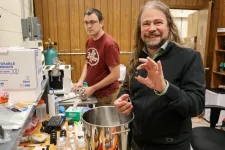(Press-News.org) Research led by the University of Michigan has provided compelling evidence that could solve a fundamental mystery in the makeup of fibrils that play a role in Alzheimer's, Parkinson's and other neurodegenerative diseases.
"We've seen that patients have these fibril structures in their brains for a long time now," said Ursula Jakob, senior author of the new study. "But the questions are what do these fibrils do? What is their role in disease? And, most importantly, can we do something to get rid of them if they are responsible for these devastating diseases?"
Although the new finding does not explicitly answer those questions, it may provide a missing piece of the puzzle for researchers that are trying to understand how these diseases work at a molecular level. And it's clear that this more intimate understanding is needed, given the lack of Alzheimer's treatment options, Jakob said.
The Food and Drug Administration has approved three new drugs for Alzheimer's disease since 2021, but that was preceded by a 17-year stretch without any new approvals despite hundreds of clinical trials (even now, there are more than 100 drug candidates being evaluated).
"Given all these unsuccessful clinical trials, we must still be missing some important pieces of this puzzle," said Jakob, a professor in the U-M Department of Molecular, Cellular, and Developmental Biology. "So the fundamental research that we and many others around the world are doing is critically necessary if we ever want to treat, much less eliminate, these terrible diseases."
The mystery density
Researchers have long known fibrils—tiny tendrils assembled from invisibly small building blocks called amyloid proteins—are connected to a number of neurodegenerative diseases. But important questions have lingered about how these structures build up in the body and how they affect the progression of these disorders.
Our understanding of the fibrils continues to develop as scientists introduce new tools and methods to probe the structures more intimately. One of those innovations is known as cryogenic electron microscopy, or cryo-EM.
"This is a very sophisticated technique," Jakob said. "With it you can see what these fibrils look like in great detail."
In 2020, an international team led by researchers in Cambridge using cryo-EM discovered a mysterious mass inside fibrils that were recovered from patients with a neurodegenerative disease called multiple system atrophy.
Although researchers could characterize the fibrils down to the individual amino acid units that build up the larger protein structure, there remained an unknown material running along the length of fibrils.
"It was right in the middle of the fibril and they had no idea what it was," Jakob said. "They called it a 'mystery density.'"
Now, Jakob and her colleagues have shown that a ubiquitous biological polymer called polyphosphate could be that mystery density.
The team reported its findings in the journal PLOS Biology.
New science, ancient molecule
Polyphosphate is a molecule found in every living thing today and has been used by organisms throughout the eons of evolution, Jakob said. It is also thought to have links to several neurodegenerative conditions thanks to laboratory experiments performed by Jakob and other scientists.
For example, her team showed that polyphosphate helps stabilize fibrils and reduces their destructive potential against lab cultured neurons. Other researchers have shown that the amount of polyphosphate in rat brains decreases with age.
These results imply polyphosphate could be important in protecting humans against neurodegenerative diseases. Still, scientists lacked direct evidence that it was.
"You can do a lot of things in test tubes," Jakob said. "The question is which are genuinely relevant in the human body."
The human brain, however, is an incredibly complex environment. Scientists have yet to design an experiment that can clearly elucidate polyposphate's role in it.
But scientists did have precise, 3D structures of real fibrils from humans thanks to earlier research. By creating computer models of those structures, Jakob and her team could run simulations that asked how polyphosphate would interact with a fibril. They found that it fit the mystery density very well.
They then took it a step further and tweaked the structure of the fibril, changing the amino acids that bordered the mystery density. When they tested these fibril variants, they found that polyphosphate was no longer associated with them and no longer protected neurons against the fibrils' toxicity.
"Because we're unable to extract polyphosphate from patient-derived fibrils—it's just not technically possible—we can't say for sure that it is really the mystery density," Jakob said. "What we can say is that we have very good evidence that the mystery density fits polyphosphate."
Their work leads to the hypothesis that finding a way to maintain proper polyphosphate levels in the brain could possibly slow the progress of neurodegenerative disease. But proving that will still take large investments of time and money, Jakob said, and there will likely be new mysteries to be solved along the way.
"I would say we are still at a very early stage. It's only very recently that it became clear that there are additional components in these fibrils," she said. "These components may play a huge role or they might not play any role at all. But only if we have the pieces of the puzzle in place, can we hope to be able to successfully fight these hugely devastating diseases."
The work was supported by the National Institutes of Health and included collaborators from Howard Hughes Medical Institute, the Manipal Academy of Higher Education and the University of California, San Francisco.
The first authors of the study were Pavithra Mahadevan, a graduate student in Jakob's lab, and Philipp Hüttemann, who performed the research as an undergraduate at U-M.
END
Finding a missing piece for neurodegenerative disease research
2024-10-31
ELSE PRESS RELEASES FROM THIS DATE:
Journal of the Royal Society of Medicine ranked in global top ten medical journals
2024-10-31
Notes to editors
For further information please contact:
Karen Nower
Media Office, Royal Society of Medicine
M: +44 (0)7587 084402
E: media@rsm.ac.uk
The Journal of the Royal Society of Medicine (JRSM) has been ranked as one of the world’s top ten general medicine journals for the first time.
Being placed tenth out of 329 ‘general and internal medicine’ titles in Clarivate’s 2023 Journal Citation Reports (JCR), this is JRSM’s highest ever ranking to date, having risen yearly ...
A new piece in the grass pea puzzle - updated genome sequence published
2024-10-31
An international research collaboration has completed the most detailed genome assembly to date of grass pea (Lathyrus sativus).
This new chromosome-scale reference genome published in Scientific Data offers new potential to accelerate modern breeding of this underutilised legume for climate-smart agriculture.
Nearly twice the size of the human genome, the sequence was assembled from scratch and improves on an earlier draft assembly of the vigorous grass pea line LS007.
“We ...
“Wearable” devices for cells
2024-10-31
CAMBRDIGE, MA – Wearable devices like smartwatches and fitness trackers interact with parts of our bodies to measure and learn from internal processes, such as our heart rate or sleep stages.
Now, MIT researchers have developed wearable devices that may be able to perform similar functions for individual cells inside the body.
These battery-free, subcellular-sized devices, made of a soft polymer, are designed to gently wrap around different parts of neurons, such as axons and dendrites, without damaging the cells, upon wireless actuation with light. By snugly wrapping neuronal processes, they could be used to measure ...
Cancer management: Stent sensor can warn of blockages in the bile duct
2024-10-31
Images
Stents to treat various blockages in the human body can themselves become blocked, but a new sensor developed at the University of Michigan for stents that are used in the bile duct may one day help doctors detect and treat stent blockages early, helping keep patients healthier.
Bile duct blockages can cause jaundice, liver damage and potentially life-threatening infections. Conditions that cause the bile ducts to narrow and close, including pancreatic and liver ...
Nov. 14 AARP Author Q&A at GSA 2024 in Seattle: Debra Whitman, Global Aging Expert and Author of ‘The Second Fifty: Answers to the 7 Big Questions of Midlife and Beyond’
2024-10-31
Author Q&A: Debra Whitman, Global Aging Expert and Author of “The Second Fifty”
Date: Thursday, November 14
Time: 4:30 to 5:30 p.m. PT
Location: Seattle Convention Center Arch Building Room 305
Registration: GSA 2024 Annual Scientific Meeting media registration is required to attend this event.
During this meet-the-author media roundtable, Debra Whitman, executive vice president and chief public policy officer at AARP, will discuss her new book, “The Second Fifty: Answers to the 7 Big ...
Autistic psychiatrists who don't know they're autistic may fail to spot autism in patients
2024-10-31
Groundbreaking research exploring the experiences of autistic psychiatrists has revealed that psychiatrists who are unaware that they themselves are autistic may fail to recognise the condition in their patients. The study, conducted by researchers from University College Dublin, London South Bank University, Brighton and Sussex Medical School, is the first of its kind to delve into the lives of neurodivergent psychiatrists. It was published today in BJPsych Open.
"Knowing that you are autistic can be positively life-changing," said the study author Dr Mary Doherty, Clinical Associate ...
New findings on animal viruses with potential to infect humans
2024-10-31
COLUMBUS, Ohio – Scientists investigating animal viruses with potential to infect humans have identified a critical protein that could enable spillover of a family of organisms called arteriviruses.
In a new study, researchers identified a protein in mammals that welcomes arteriviruses into host cells to start an infection. The team also found that an existing monoclonal antibody that binds to this protein protects cells from viral infection.
Arteriviruses circulate broadly in many types of mammals around the world that serve as natural hosts – such as ...
Ancient rocks may bring dark matter to light
2024-10-31
The visible universe — all the potatoes, gas giants, steamy romance novels, black holes, questionable tattoos, and overwritten sentences — accounts for only 5 percent of the cosmos.
A Virginia Tech-led team is hunting for the rest of it, not with telescopes or particle colliders, but by scrutinizing billion-year-old rocks for traces of dark matter.
In leading a transdisciplinary team from multiple universities on this unconventional search, physics’ Patrick Huber is also taking an unconventional step: from theoretical work into experimental work.
With support from a $3.5 million Growing Convergence Research ...
Study reveals acceleration in Pacific upper-ocean circulation over past 30 years, impacting global weather patterns
2024-10-31
A new study published October 31, 2024, in the Journal of Geophysical Research: Oceans has revealed significant acceleration in the upper-ocean circulation of the equatorial Pacific over the past 30 years. This acceleration is primarily driven by intensified atmospheric winds, leading to increased oceanic currents that are both stronger and shallower, with potential impacts on regional and global climate patterns, including the frequency and intensity of El Niño and La Niña events. The study provides a spatial view of these long-term trends from observations, adding at least ...
Virginia Tech researcher finds AI could help improve city planning
2024-10-31
Traditional city planning methods require significant technical expertise and manual work.
A Virginia Tech researcher is working to change that.
New research shows the potential of large language models (LLMs), such as ChatGPT and Google’s Gemini, for assessing the human-made environment using street-view images.
By comparing LLM performance with traditional city planning deep learning methods, the study from the College of Natural Resources and Environment found that LLM-based performance is similar with established approaches. Unlike ...






